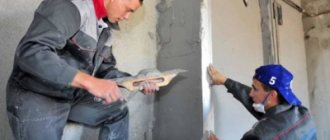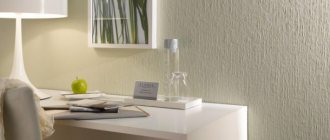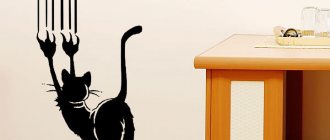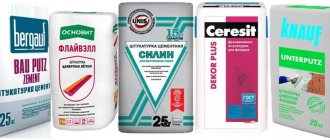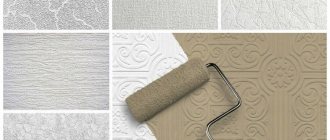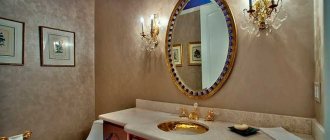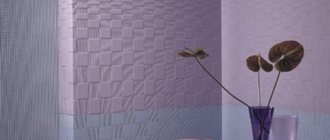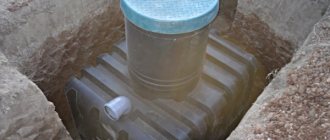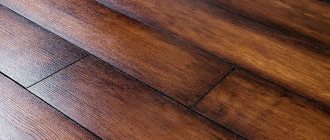The development of technological progress gives rise to new types of finishing materials, which affects the consumer in two ways: on the one hand, the possibilities for original interior design are expanding, on the other, the consumer will have to make a difficult choice between the products available for sale. Under these conditions, buyers most often make a choice between the classics, which are represented by wallpaper, and a group of innovative materials under the general name “decorative plaster.”
It’s always easier to decide if you have a comparative analysis of the main characteristics of the materials at hand. We will provide such data to the buyer and analyze which is better, wallpaper or decorative plaster.
Criteria for choosing a wall finishing method
With the crisis, durability became the most important quality. And wallpaper here is outright inferior to plaster. Unless, of course, we are talking about liquid wallpaper, which can be updated very quickly and easily. The plaster is strong and can withstand significant physical impact. Wallpaper almost always deteriorates. We can accidentally touch them when carrying furniture and other loads, but our beloved cats very often touch the wallpaper with their claws. So, the prospect of re-finishing it in a short time, or sitting with shabby walls, does not appeal to us.
The second criterion is price, and wallpaper wins here. After all, even the cheapest decorative plaster for walls costs two hundred rubles and more. At the same time, wallpaper can be found for 50 rubles. Of course, there are expensive fabric and metal wallpapers, as well as expensive Venetian plaster. However, in general, wallpaper is still more affordable. If you do not take into account everything that is written in the paragraph above, and exclude the possibility of repeated spending on replacing damaged wall coverings.
Ease of use is also an important factor for those who are planning to do the repairs themselves. It is much easier to hang wallpaper before painting. Options with patterns are already more complicated. Well, the most difficult ones are photo wallpapers, where you need to combine everything very precisely. But even in this case, the process is still simpler than plastering. And therefore, those who have previously had experience working with wallpaper, but have not held a spatula in their hands, are unlikely to decide to plaster the walls.
By the way! In quite a number of cases you will have to work with putty even when hanging wallpaper. After all, the walls in our houses are very mediocre in terms of quality, and often they need to be leveled. Without this, it simply won’t be possible to hang high-quality wallpaper.
Comparison of characteristics
Any selection is carried out according to certain criteria. In relation to the materials in question, these are:
- vapor permeability. Many owners of apartments and private houses pay little attention to the ability of finishing materials to allow air and water vapor to pass through. But the microclimate in the room depends on whether the walls “breathe” or not, since a vapor-proof film leads to the appearance of dampness and an increase in the amount of carbon dioxide;
- price of material and cost of finishing work. In many cases, it is finance that dictates the choice of type of finish. Then, instead of what is more beautiful and practical, they look for what is cheaper. Unfortunately, these are the realities of Russia that must be taken into account;
- resistance to external influences. Generalizing criterion. Includes the entire range of factors that have a negative impact on the finishing surface, ranging from mechanical stress to the ability to retain color when exposed to sunlight;
- durability. The effectiveness of financial investments in repair work depends on the service life. Many consumers take this factor into little account. For example, they buy finishing material, which costs 25-30% less than the alternative option, but lasts 2-2.5 times less;
- complexity of installation technology. The criterion is directly related to finance. It’s one thing when you do the work yourself, it’s another thing to hire a team of professional builders. And even here there is a huge difference in prices. For example, painting walls will cost inexpensively, about 70 rubles/m2, “Venetian” is many times more expensive - from 400 to 1500 rubles/m2;
- environmental friendliness. For apartment owners who are susceptible to allergic reactions to various substances and materials, this indicator is very important;
- moisture resistance. The reaction of the finishing material to high humidity determines its use in a particular room;
- ease of care. The indicator is important, but not decisive. They pay attention to him last.
The criteria are defined. Let's compare wallpaper and decorative plaster.
Vapor permeability
In both groups of materials, there are types of finishing that allow steam and air to pass through in both directions (paper- and non-woven-based trellises, cement-sand and gypsum mortars) and sealed ones: vinyl wallpaper and polymer latex mixtures.
Conclusion: the materials have absolute equality.
Cost factor
It is necessary to compare materials according to the financial factor in two positions:
- price of material;
- cost of finishing work.
In terms of cost of material in the budget sector, the undoubted leader is wallpaper. You can buy them at a discount for 45-50 rubles/m2. The price of the cheapest plaster starts from 200 rubles/m2.
In the middle price sector, the advantage of wallpaper remains, but the gap is significantly smaller. In the “elite” class there is an approximate equality: 1 m2 of 3D wallpaper costs 1,000-2,500 rubles/m2, decorative plaster costs 1,200-2,100 rubles/m2.
In terms of cost of work, wallpaper also has an undoubted advantage. You can order a specialist to paste the walls from 80 rubles/m2; specialists will undertake plastering for 325 rubles/m2 or more.
Conclusion: with limited funds for repair work, it is more profitable to cover the walls with wallpaper.
Resistance to external influences
According to this criterion, plaster solutions have an overwhelming advantage: pet claws, ultraviolet radiation, impacts, scratches with sharp objects, constant friction with the back of a chair, etc. decorative plaster tolerates better than trellises.
Conclusion: the high resistance of plaster to various influences increases the service life of this type of finish.
Durability
When carrying out finishing work, every home owner wants to get the end result a product that will please the eye for the maximum possible number of years. Plaster has no competition here. Thus, the average service life of wallpaper is 7-8 years (paper 5-6 years, non-woven - 10-15 years), decorative plaster - 45-50 years (mineral compositions last about 30 years, polymer - at least 50 years, silicone - more than 60 years).
Conclusion: in the long term, it is more profitable to invest in expensive decorative plaster than in cheap material.
Complexity of installation technology
Almost any family member can hang wallpaper. Only a professional with experience can perform plastering work of increased complexity (Venetian, wet silk, etc.). Although, there are rare craftsmen who perform this type of work at a fairly high level. But this is the exception rather than the rule.
Conclusion: applying decorative plaster requires knowledge and experience from the master. Beginners in the construction business are still unable to perform this type of technological operation.
Environmental friendliness
There is complete equality in the question of what is more environmentally friendly. All types of finishing materials in each analyzed group are made from environmentally friendly materials. Some consumers only have doubts about vinyl wallpaper. But problems with them begin only in extreme situations (fire), which allows you to ignore the property of vinyl to release harmful substances when burning.
Conclusion: allergy sufferers can afford any type of finishing material.
Moisture resistance
Modern technologies have made it possible to put an equal sign among materials in their relation to moisture. Both groups contain moisture-resistant materials and finishes that are destroyed by direct contact with water.
Conclusion: when using wallpaper or decorative plaster in rooms with high humidity, you must look at the instructions for use or read the recommendations on the packaging.
Which is easier to clean?
If we take into account consumer reviews on various forums, a more practical material is decorative plaster. It can be washed with household chemicals. However, the author’s personal experience shows that not everything is so simple: difficulties arise when removing dust and dirt from textured plaster. It is especially difficult if there are a large number of micro-depressions, not like those of the “lamb”, but smaller.
Conclusion: decorative plaster, although difficult, can be washed, but trellises are not always cleanable. In some cases, they can only be vacuumed.
At the end of the analysis, we note an important point: there was no comparison of materials by appearance. There can be no assessments here, since everyone has their own concept of beauty. Some admire the illusion of spaciousness of 3D wallpaper, while others admire natural stone walls.
Important: if the question is which is better, wallpaper for painting or decorative plaster, you can fully rely on the conclusions made in this work: after all, wallpaper for painting has almost the same characteristics as simple trellises, with the exception of the service life. It reaches 20 years or more.
Liquid wallpaper is a worthy alternative
If you can’t decide what would be the best way to decorate your walls – decorative plaster or wallpaper, then why not try their liquid version?
We have already said that wallpaper can be damaged very easily, which cannot be said about plaster. However, the plaster can also be chipped, scratched or knocked out of the wall. And replacing it in this case is very, very difficult. The same cannot be said about liquid wallpaper - the damaged fragment can be removed and covered with a small amount of the newly diluted composition. But these are not all the advantages of liquid wallpaper:
- Liquid wallpaper is cheaper than plaster - their price starts from 150 rubles, although it is still better to purchase more expensive options;
- This type of wallpaper is very easy to apply. Even a beginner can handle the process;
- There is no need to cut or calculate anything. You can prepare a solution for applying to walls even in a limited space, which is impossible when using conventional wallpaper;
- By combining different colors of liquid wallpaper, a person with taste can create wall coverings that are unique from a visual point of view.
At the same time, you need to understand that liquid wallpaper, although cheaper than good plaster, is still more expensive than its traditional counterparts. Also, regular wallpapers still have greater visual variety. Finally, liquid wallpaper, as manufacturers say, is not afraid of water. But in fact, it won’t be possible to fully wash them, like washable wallpaper.
Types and features of material
Both wallpaper and decorative plaster are just collective designations for two large groups of finishing materials.
They can differ significantly from each other both in their technical characteristics and in appearance, so you should look in more detail at how this or that type of wallpaper or plaster differs from its “brothers”.
The nuances of applying decorative plaster
- In order for decorative plaster to fit better on the wall, the wall itself does not need to be leveled. On the contrary, an increase in the number of irregularities will provide better grip on the surface. As an alternative, a primer containing quartz sand can be used. In this case, it will be possible to achieve excellent adhesion to the wall surface;
- Typically, plaster is applied for decorative purposes in several layers. At the end, in order to give the required surface, you can grout with fine sandpaper. It is necessary to rub after about 20 minutes, as soon as the palm stops sticking to the surface of the wall;
- Under no circumstances apply plaster to walls in a room where the temperature is below 5 degrees Celsius;
- It is best to use paint rather than tinting the plaster. The reason is that when drying, leveling with sandpaper leaves marks on the tinted plaster. Thus, it is more logical to paint the surface after it has been leveled. At the same time, during painting, you can resort to various design steps, highlighting certain segments;
- You can get a stylish uneven surface by applying decorative bark beetle plaster. Even a beginner can decorate walls this way. Well, if you have the skills, it will help to finish the ceiling.
Price
Even the most inexpensive plasters will be more expensive than wallpaper
. Wallpaper undoubtedly holds the crown in terms of affordability.
Even the most inexpensive varieties of decorative plaster will cost much more than wallpaper from the highest price segment.
In this case, most often the choice looks like this: “liquid wallpaper or decorative plaster.”
According to calculations, a square meter of wall covered with simple textured plaster, not to mention “Venetian”, will cost several times more than a square covered with liquid wallpaper.
Venetian plaster
This is an option for those who have money and are willing to spend it on creating the highest level of interior design in their premises. In addition, get ready to spend money on specialists who know how to work with this material. After all, improper application of such finishing material can ruin the entire final effect.
“Venetian” imitates the effect of expensive stone and marble on the walls. It is mainly used to create interiors in the style of palaces and similar designs. However, it can also be used in modern interiors, since branded patterns on the walls can be appropriate in many cases.
And despite its considerable price (from 1000-1200 rubles per square meter), this finishing method is still cheaper than using real marble. Moreover, the latter is not advisable always and not everywhere.
